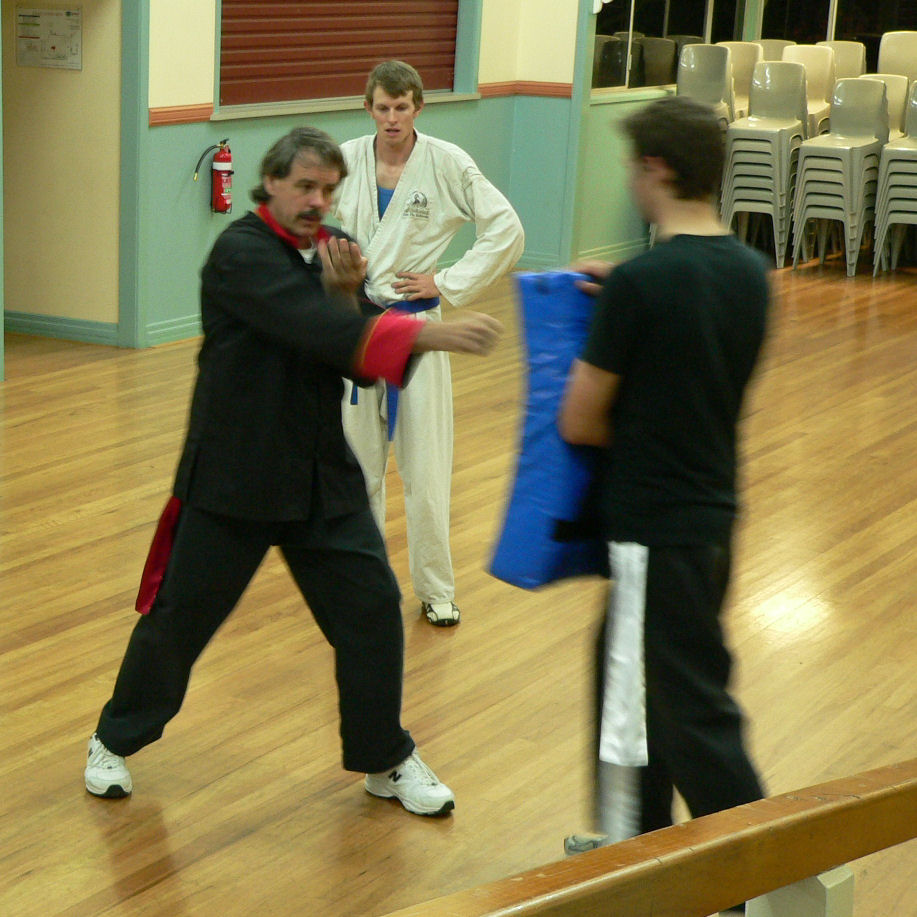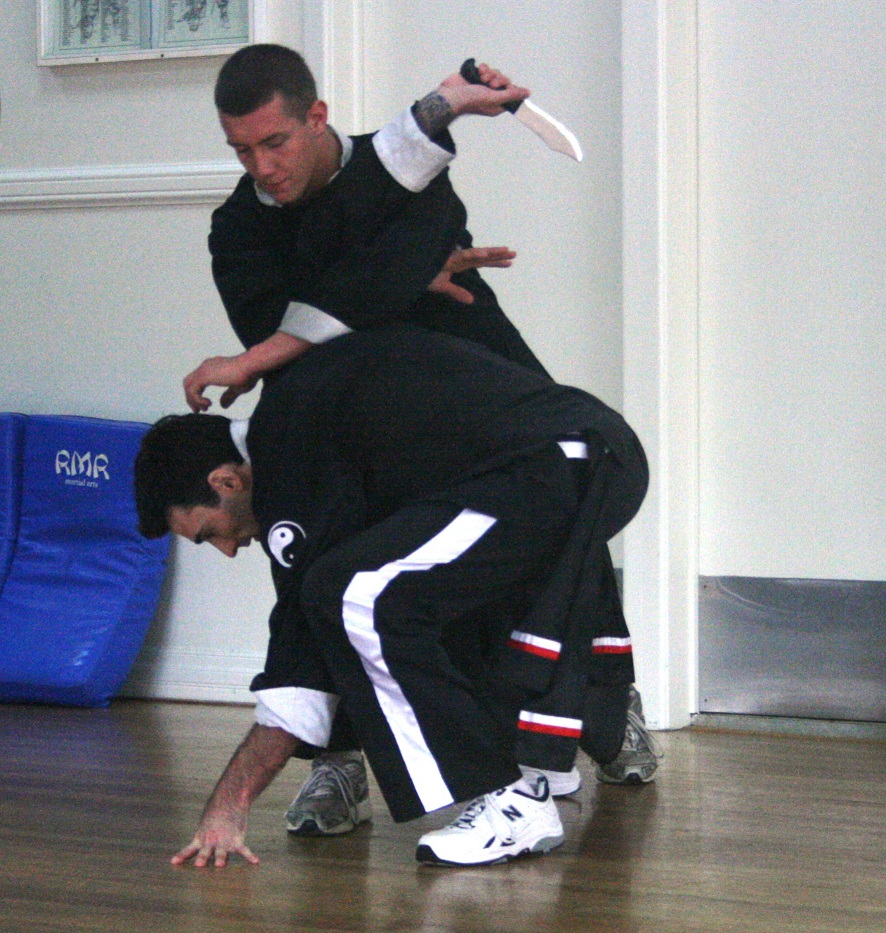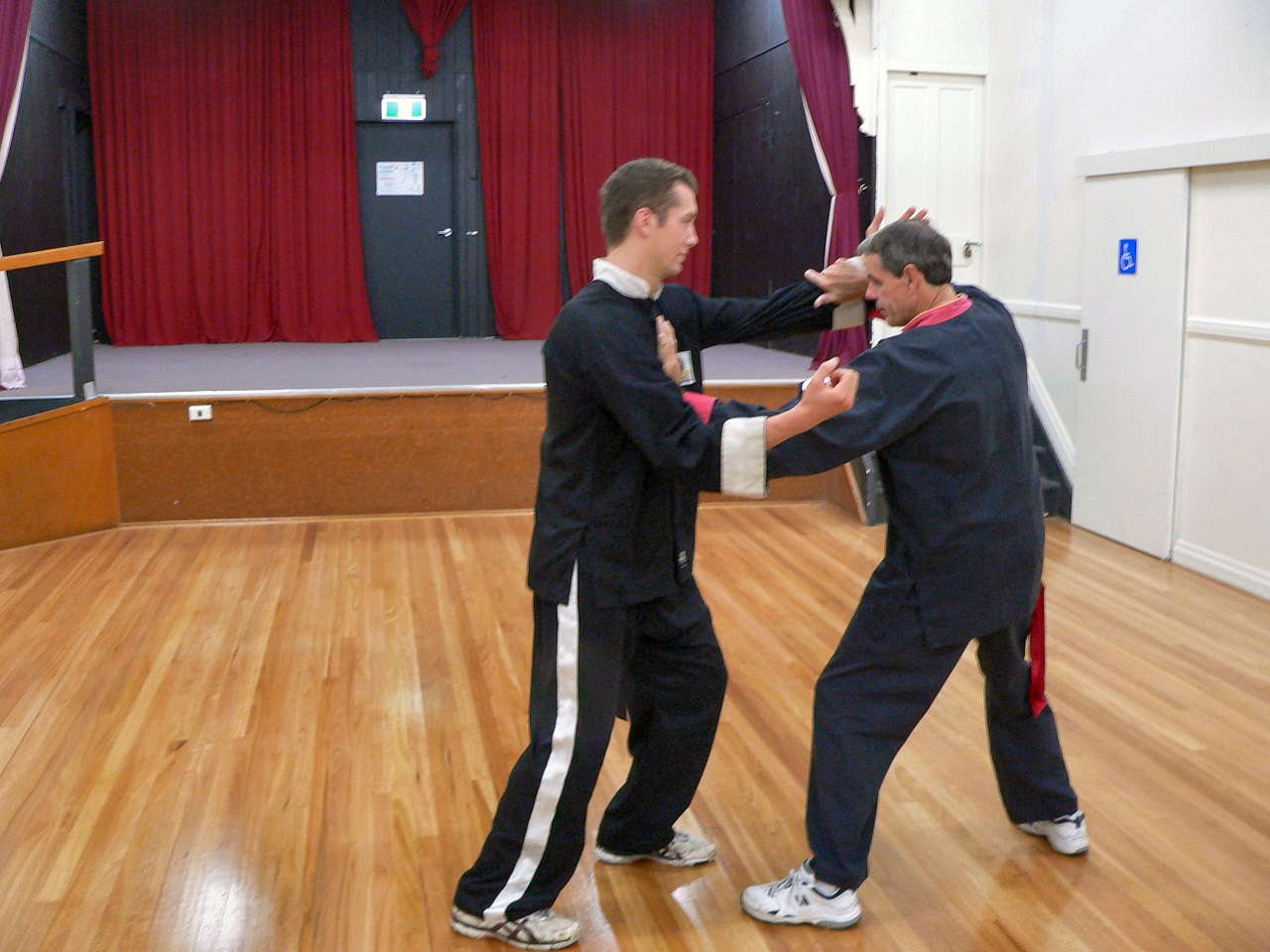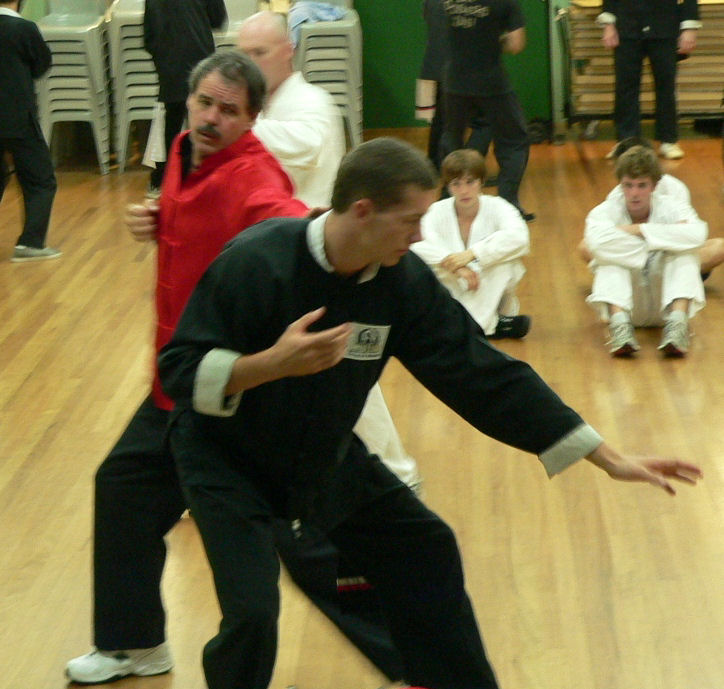Traditional Kung Fu Training
Deployed in the correct method power can also be obtained from twisting, rising, dropping and projecting using circular movements or straight line attacks. These are all methods of Kinetic Energy taught in the schools giving them the ability to generate a large amount of power on their blocks and strikes. These are primarily external strikes generated by coordinated body movement preformed completely relaxed and at high speed.
More powerful strikes can be dealt by instructors using internal strikes where the chi is focused, then moved through the body via meridians and unleashed into the opponent or attacker using a multitude of blocks, punches and strikes. The study of Hsing I Chuan involves two levels of discipline. The first level consists of understanding the way of power, naturally cultivating the chi. The second level consists of understanding how to dissolve power, learning how to change the marrow in the body, achieving a state of spiritual emptiness. Using the chi to generate power or energy has three stages of development to cultivate ‘jieng’ or seminal essence into chi; to cultivate chi into ‘shen’, or spiritual essence; to cultivate ‘shen’ back into emptiness or prenatal state. Simultaneously with advancements through these stages there occur three changes in your body: the transformation of the bones; the transformation of the muscles and the transformation of the spinal cord.

Obvious Energy (Visible strength)
To get obvious energy you must be centred and balanced. Through this seminal essence ‘jieng’ is worked into chi, which changes the bones. After concerted practice, the dispersed chi is concentrated at the Dan Tien and all parts of the body become coordinated. When you stand and move, your bones become solid, holding your body like a mountain. ‘This is called ‘Little Heaven.’
Concealed Energy (Invisible strength)
Concealed energy is natural, free, relaxed, and soft (elastic). It deals with changing chi into spiritual essence ‘shen.’ The changing of the sinews is to fuse energy into and through all sinews, forming membranes to them. These are then energized binding and strengthening the muscular structure of the body. This is called ‘Big Heaven.’
Mysterious Energy (Refined inner strength)
The last stage is called mysterious energy evolving from concealed energy, the result of marrow washing, were spiritual essence ‘shen’ is refined back into emptiness, or prenatal state. To clean the bone marrow is to relax completely and purify and refine the internal organs by using your mind, it is soft and uses no strength. You are able to move more easily because the energy is concentrated, making your body as light as a feather. This energy merges you with emptiness, the Tao. The energy derived is different from actual strength although the actions taken are the same the energy stays inside controlled by the mind.

Chin Na
The Black Crane Kung Fu Schools teach Chin Na techniques as part of the Black Crane Systems training syllabus. In this system there are five levels of Chin Na taught. Chin Na roughly translated means ‘to seize control’, with Chin meaning ‘to seize’ and Na meaning ‘to control’. The first two levels are fundamental in their application using basic techniques and principles to stop an aggressive action without maiming or injuring a person too seriously. This is achieved by grasping, pressing or unnaturally twisting sensitive parts of an opponent’s body such as muscles, joints and nerves. The other levels are more advanced requiring a lot more knowledge in anatomy and the cycles of chi within the body. These levels include a certain number of strikes that will cause momentary paralysis or unconsciousness, there are some Chin Na techniques that are used to maim or kill an opponent, but the location of these cavities are always a well kept secret within any style.
Five levels of Chin Na
Tsuoh Guu - Misplacing the Bone
With misplacing the bone Chin Na you are applying a great deal of stress on the joints so as to break, dislocate or unhinge them. You have two options on how you can control your opponent. The first is by placing an unnatural twist to the joint setting up a chain reaction in the surrounding nerves, muscles and ligaments. This stretching of the muscles and ligaments connected to the joint produces severe pain allowing you control over your opponent. The second option is to stop the function of the joint, effectively stopping all movement. This option usually requires the joint to be broken or dislocated, incapacitating your opponent.

Fen Gin - Dividing the Muscle
With dividing the muscle there are three separate types of techniques used twisting, grasping and pressing. The twisting technique overextends and twists certain groups of muscles causing temporary lose of function and movement. The twisting of the muscles also places the nerves under pressure causing severe pain. The grasping and pressing techniques operate on similar principles. That is the understanding that the function of the muscle is to either extend or retract a limb. This is achieved by the muscle contracting and that the location of the muscle determines whether the limb is extended or retracted. There are seven zones used for attack in dividing the muscle Chin Na and these are sometime referred to as sensitive zones as they all have prominent nerves that pass through the general area of the zone. These zones are located on the hand, arm, shoulder, waist, leg, chest and neck. When these muscles in the sensitive zones are grasped and pulled and forced into unnatural positions the nerves are aggravated and produce severe pain and local paralysis. In some cases when attacking the sensitive zones pressing techniques are required to produce severe pain and paralysis as the nerves lay under the muscles and need pressure to aggravate them.

Bih Chi - Sealing the Breath
With sealing the breath there are two different methods used to render a person unconscious. The first involves either breaking or closing the wind pipe. Breaking the wind pipe requires only a punch or grab to the throat, while closing the wind pipe usually requires a choking technique to be applied by the arms or the legs, squeezing or pressing together the sides of the wind pipe restricting the flow of oxygen to the body. The second method is to constrict the lungs. This is achieved by attacking the nerves that run through the big muscle groups that surround the lung. By striking the nerves, using either internal powers or penetrating strength the muscles will contract violently rendering the person unconscious due to overwhelming pain. The violent contraction of the muscle will also constrict the lung resulting in the inability to take in oxygen. The muscles used as striking areas for sealing the breath Chin Na are found at the solar plexus, the sides of the chest, on the shoulder blade and at the side of the waist.

Duann Mie - Sealing the Vein
With sealing the vein the attacking areas are the jugular vein and the carotid artery found on both sides of the neck. The attacking areas are either struck or squeezed shut using a choking or clamping technique. This stops any blood from reaching the brain and within seconds the person will lapse into unconsciousness and if not revived may die. For this reason it is most important that when studying advanced levels of Chin Na you also learn how to revive your unconscious assailants.

Tien Hsueh - Cavity Press
With cavity press you attack the cavities directly, as cavities are intimately related to the circulation of the chi through the nervous system. Cavities act as a gate to the exposed part of a general nerve system through which various parts of the body can be stimulated. These points or gates can easily be stimulated as they usually lack sufficient protection from bones, muscles, ligaments or tendons. The stimulation of these points can alter the circulation of the chi. In traditional Chinese medicine there are twelve meridians that are associated with various organs and the two vessels. On these 14 pathways rest more than 700 cavities that are used by Chinese acupuncture to cure disease or relieve pain. Of these 700 cavities only 108 cavities are use to attack the body, as some acupuncture cavities are too small or require too much power to be affective, while other cavities are located in obscure areas and are not practical to attack. There are 72 cavities on the body that are used to create unconsciousness, local paralysis or pain; the remaining 36 cavities are used to kill.

Chin Na Techniques
To recap many Chin Na techniques are intended to control an attack without maiming or killing. However there are lethal techniques which are used in dire circumstances and these techniques are meant to control a person by death. Chin Na techniques are divided into two levels: fundamental and advanced. The fundamental levels of Chin Na misplacing the bone and dividing the muscle require little knowledge of Chin Na theory and with just a basic understanding of human anatomy; the techniques can be applied by using simple external strength. The advanced levels of Chin Na include sealing the breath, sealing the vein and cavity press. They require a sound knowledge of Chin Na theory using aspects of traditional Chinese medicine and a comprehensive understanding of human anatomy. These techniques need to be applied using internal power or penetrating strength.

